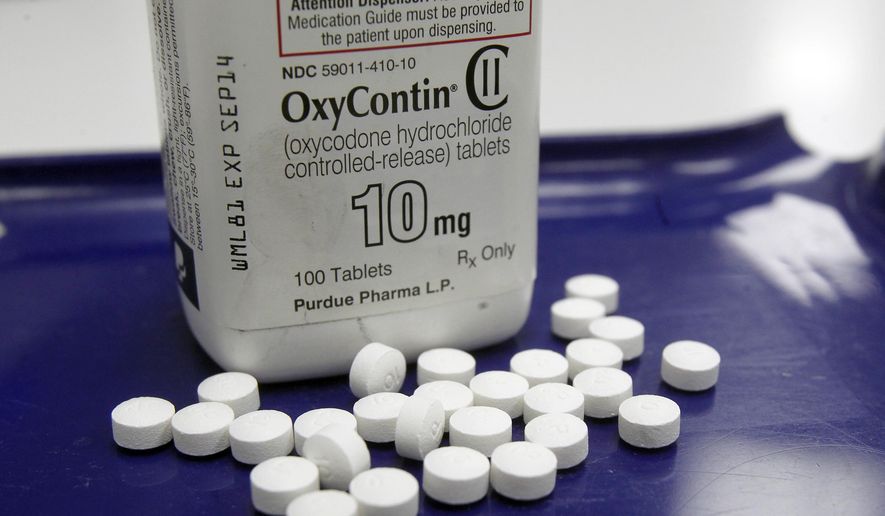The rate of opioid overdose deaths began to plateau in early 2018, notching a victory for public health officials — but like water seeking the path of least resistance, adaptive drug cartels are turning back to the previous moneymakers of cocaine and methamphetamine.
Mexican cartels have replaced U.S. meth production with an incredibly cheap and potent supply, smuggled across the border or even produced in cartel-run labs tucked in national forests in places such as California.
Meth-related deaths spiked from the low thousands earlier this decade to about 10,000 in 2017, according to federal data.
“We’re seeing an explosion,” said Mike Stuart, U.S. attorney for the southern district of West Virginia, which saw its largest-ever meth seizure in October.
Other states say they’re seeing an uptick in cocaine use, as coca cultivation in Colombia and the Andean region surges. Cocaine overdose deaths roughly doubled from 2015 to 2017, topping 14,500.
The numbers are far less than the 47,600 killed in 2017 in opioid-related deaths, but the trend lines suggest America’s drug epidemic remains a diffuse, evolving menace.
“Policymakers and the public get fixated on one drug at a time: Heroin in the 1970s, cocaine in the 1980s, methamphetamine in the 1990s, opioids now,” said Keith Humphreys, a Stanford University professor who tracks substance-abuse issues. “But the reality is that we have diverse addiction problems all through those decades.”
Most of the meth supply is coming across the border, through legal crossings or in some cases over border fences, experts say.
“The Mexican meth is so cheap you couldn’t make it for cheaper than you could buy it,” said Van Ingram, executive director of the Kentucky Office of Drug Control Policy.
Overdose deaths from meth increased in his state by 29 percent from 2016 to 2017, and preliminary figures for this year suggest the situation isn’t improving.
Part of the problem is higher potency as synthetic opioids are increasingly cut with other drugs.
“I’m trying to get the story out every chance I can, that meth is being combined with fentanyl,” Mr. Ingram said.
Cocaine, meanwhile, is attracting a new generation of users, with fentanyl playing a role there, too. Connecticut, for example, said deaths from a mix of cocaine and fentanyl more than quintupled from 42 in 2015 to 220 in 2017.
“We have to get to the bottom of what’s going on there,” Health and Human Services Secretary Alex M. Azar II told a recent health care event hosted by the Axios news outlet.
Use rates also are rising. Nearly 2 percent of young adults ages 18 to 25 were using cocaine from 2015 to 2017, possibly double the rate earlier in the decade, according to a national drug survey released in the fall.
“Record levels of coca cultivation and cocaine production in Colombia, the primary source for cocaine seized and tested in the United States, has widened the cocaine market, leading to increased domestic abuse,” said Drug Enforcement Administration spokesman Melvin Patterson.
In a way, it’s not surprising that cocaine and meth are making a comeback.
An uptick in stimulant use often follows a heroin or painkiller crisis. Users typically turn to the stimulants as officials crack down on opioids — or, they try to offset the sedative affect of opioids or enjoy the combined effect of the two types of drugs.
Experts say the government should continue to take a holistic look at the national drug problem through grants that target a wide spectrum of addictions.
Congress took a step in that direction as part of it last round of opioid-related bills. It said people addicted to cocaine will be eligible for greater Medicaid assistance in states that waive an antiquated cap on funding for large treatment facilities.
Rep. Bobby Rush, Illinois Democrat, had pushed for the change, citing racial disparities in cocaine and opioid use.
And in the fall, White House drug “czar” Jim Carroll said Colombian President Ivan Duque committed to a plan that seeks to cut coca cultivation in half within five years.
In Kentucky, Mr. Ingram said patrols have stepped up their vigilance on key trafficking highways, hoping to stop more meth and other drugs.
Mr. Stuart, meanwhile, said his big bust in October — dubbed “Project Parkersburg” — seized 150 pounds of meth and involved agents from four states, proving agents can fight the emerging problem effectively.
“We have all hands on deck in fighting the opioids crisis — the height of that might have been two years ago. It’s important right now that we’re ready and tackling the meth crisis that’s going to happen, and that we’re hitting the cocaine crisis,” Mr. Stuart said. “There’s always going to be a demand for illegal and illicit drugs.”
• Tom Howell Jr. can be reached at thowell@washingtontimes.com.




Please read our comment policy before commenting.